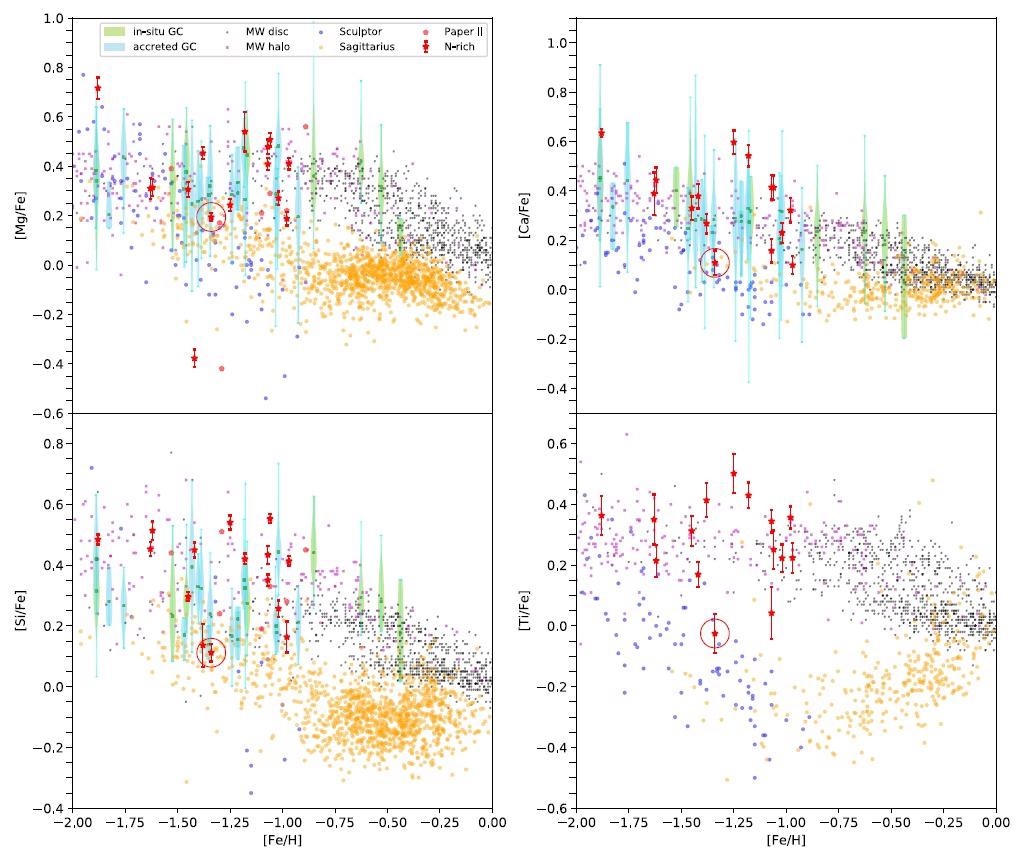Nitrogen is a gas that mostly appears colorless or odorless and constitutes 78% of the Earth’s current atmosphere. However, nitrogen is produced in stars shining throughout the Universe, similar to most of the elements heavier than helium.
 The relation between abundances of alpha-elements and metallicity for different sources (N-rich field stars, globular clusters, Milky Way field stars, extragalactic field stars, etc. Image Credit: YU Jincheng.
The relation between abundances of alpha-elements and metallicity for different sources (N-rich field stars, globular clusters, Milky Way field stars, extragalactic field stars, etc. Image Credit: YU Jincheng.
A small group of stars called “field stars” (stars that are not part of star clusters) in the Milky Way galaxy have been found to contain more nitrogen elements than others. Such stars are referred to as “N-rich field stars.” The formation of those stars and the place from where they come are still mysterious.
Dr. Jincheng Yu and Professor Baitian Tang from Sun Yat-sen University employed high-resolution spectroscopic data obtained from the Magellan Clay telescope and offer new observational proof disclosing the origin of “N-rich field stars.” The study was reported in The Astrophysical Journal.
Conventionally, globular clusters (GCs) had been regarded as simple stellar population systems. This implies all the member stars developed from the same molecular cloud and share the same age and chemical composition. Yet, numerous studies have demonstrated that nearly all GCs host two or more groups of stars with various chemical abundances, or what are called the multiple populations.
“Second-generation” stars are those that have higher sodium, nitrogen, and at times silicon, helium and aluminum, but depleted oxygen, carbon and sometimes magnesium. They are different from the primordial “first-generation” stars.
A majority of the scenarios attempting to describe this phenomenon presume that chemically enriched second-generation stars were developed in a light-element-polluted environment that is mixed partially with the ejecta of first-generation stars.
The unique chemical pattern enables us to identify the second-generation stars from globular clusters, which is crucial to reveal the co-evolution of Milky Way and globular clusters.
Dr Jincheng Yu, Study Lead Author, Sun Yat-sen University
Baitian Tang, professor and the study’s corresponding author, headed a project that has found more than 100 N-rich field stars based on the Large Sky Area Multi-Object Fiber Spectroscopic Telescope (LAMOST) survey, which is considered one of the biggest homogenous samples of N-rich field stars for sequel studies.
LAMOST is run by the National Astronomical Observatories of the Chinese Academy of Sciences (NAOC).
To completely comprehend the origin and evolution of N-rich field stars, an international research group, involving members from China and Chile, acquired the high-resolution spectra for 15 N-rich field stars over three nights in the Magellan Clay telescope. The researchers quantified the accurate abundances of more than 20 elements, which can be utilized as “name tags” for stars to determine their birthplaces.
Their chemical pattern is highly consistent with globular cluster second-generation stars. It is a strong evidence to support their globular cluster origin.
Dr. Jincheng Yu, Study Lead Author, Sun Yat-sen University
A very unique N-rich field star with very low alpha-element (for example, titanium silicon, calcium and magnesium) abundances has been spotted.
Its low alpha abundances are consistent with those of extragalactic stars, which imply slower chemical enrichment. The extragalactic origin of this star is also confirmed by its dynamics.
Baitian Tang, Study Corresponding Author and Professor, Sun Yat-sen University
“Our findings also help us in understanding how N-rich field stars form, and how they leak into Milky Way,” added Dr. Yu.
Journal Reference:
Yu, J., et al. (2021) Chemical Tagging N-rich Field Stars with High-resolution Spectroscopy. The Astrophysical Journal. doi.org/10.3847/1538-4357/abf64d.